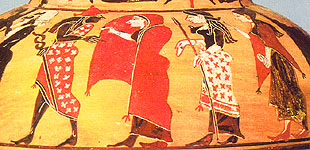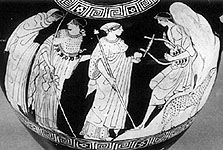
 At the wedding of Peleus and Thetis, Paris of Troy was appointed by the gods to choose between three goddesses who claimed to be the most beautiful; Hera, Aphrodite, and Athena. The Judgement is conducted by Hermes who in early art is shown restraining Paris, who flees from the goddesses. Paris is sometimes shown as a shepherd; the encounter was on Mount Ida. He chose Aphrodite and in return she promised to give him Helen, the most beautiful woman on earth. Helen was already married to a Greek king (Menelaos), and after Paris carried her off to Troy, the Greeks laid siege to the city and the Trojan War began.
At the wedding of Peleus and Thetis, Paris of Troy was appointed by the gods to choose between three goddesses who claimed to be the most beautiful; Hera, Aphrodite, and Athena. The Judgement is conducted by Hermes who in early art is shown restraining Paris, who flees from the goddesses. Paris is sometimes shown as a shepherd; the encounter was on Mount Ida. He chose Aphrodite and in return she promised to give him Helen, the most beautiful woman on earth. Helen was already married to a Greek king (Menelaos), and after Paris carried her off to Troy, the Greeks laid siege to the city and the Trojan War began.
Above left: Hermes leads the goddesses. Detail from a Pontic black-figure clay vase, about 550 BC. Munich, Antikensammlungen 837. © Antikensammlungen, Munich Licence Plate 11 UK 1007 162
Above right: Detail from Athenian red-figure clay vase, about 500-450 BC. London. British Museum E178. Photo. Mus. 222039. © British Museum